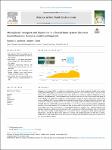Microplastic transport and deposition in a beach-dune system (Saunton Sands-Braunton Burrows, southwest England)
| dc.contributor.author | Anderson, RJ | |
| dc.contributor.author | Turner, A | |
| dc.date.accessioned | 2024-04-24T09:52:46Z | |
| dc.date.available | 2024-04-24T09:52:46Z | |
| dc.date.issued | 2024-01 | |
| dc.identifier.issn | 0048-9697 | |
| dc.identifier.issn | 1879-1026 | |
| dc.identifier.other | 168535 | |
| dc.identifier.uri | https://pearl.plymouth.ac.uk/handle/10026.1/22299 | |
| dc.description.abstract |
Although microplastics (MPs) are ubiquitous contaminants that have been extensively studied in the marine setting, there remain gaps in our understanding of their transport and fate in the coastal zone. In this study, MPs isolated from surface sediments sampled from a large beach-dune complex in southwest England have been quantified and characterised. Concentrations above a detectable size limit of 30 to 50 μm ranged from about 40 to 560 MP kg-1 dry weight but, despite local sources of plastics such as an estuary and seasonal tourism, there were no significant differences in median concentrations between different orthogonal foreshore transects and the dunes or according to zonal location on the beach. The majority of MPs were black and blue fibres of <1 mm in length that were constructed of polymers of density > 1 g cm-3 (e.g., rayon, polyester, acrylic). A significant correlation was found between MP concentration and the proportion of very fine sand (100 to 250 μm) but relationships with other granulometric or compositional markers of sediment (e.g., volume-weighted mean diameter, circularity, calcium content) were not evident. An association of MP concentration with very fine sand was attributed to similar particle depositional characteristics and the entrapment of fibres within small interstitial spaces. Overall, the observations reflect the wavelaid and windlaid deposition of MPs from a diffuse, offshore source, and, despite their role as accumulators of particles from the foreshore, dunes do not appear to act as a landward barrier of MPs. | |
| dc.format.extent | 168535-168535 | |
| dc.format.medium | Print-Electronic | |
| dc.language | en | |
| dc.publisher | Elsevier BV | |
| dc.subject | Fibres | |
| dc.subject | Rayon | |
| dc.subject | Anthropogenic | |
| dc.subject | Deposition | |
| dc.subject | Aeolian | |
| dc.subject | Grain size | |
| dc.title | Microplastic transport and deposition in a beach-dune system (Saunton Sands-Braunton Burrows, southwest England) | |
| dc.type | Journal Article | |
| plymouth.author-url | https://www.ncbi.nlm.nih.gov/pubmed/37977395 | |
| plymouth.volume | 909 | |
| plymouth.publication-status | Published | |
| plymouth.journal | Science of The Total Environment | |
| dc.identifier.doi | 10.1016/j.scitotenv.2023.168535 | |
| plymouth.organisational-group | |Plymouth | |
| plymouth.organisational-group | |Plymouth|Research Groups | |
| plymouth.organisational-group | |Plymouth|Faculty of Science and Engineering | |
| plymouth.organisational-group | |Plymouth|Faculty of Science and Engineering|School of Geography, Earth and Environmental Sciences | |
| plymouth.organisational-group | |Plymouth|Research Groups|Marine Institute | |
| plymouth.organisational-group | |Plymouth|REF 2021 Researchers by UoA | |
| plymouth.organisational-group | |Plymouth|Users by role | |
| plymouth.organisational-group | |Plymouth|Users by role|Current Academic staff | |
| plymouth.organisational-group | |Plymouth|Research Groups|BEACh | |
| plymouth.organisational-group | |Plymouth|REF 2021 Researchers by UoA|UoA07 Earth Systems and Environmental Sciences | |
| plymouth.organisational-group | |Plymouth|REF 2029 Researchers by UoA | |
| plymouth.organisational-group | |Plymouth|REF 2029 Researchers by UoA|UoA07 Earth Systems and Environmental Sciences | |
| dc.publisher.place | Netherlands | |
| dcterms.dateAccepted | 2023-11-10 | |
| dc.date.updated | 2024-04-24T09:52:43Z | |
| dc.rights.embargodate | 2024-04-25 | |
| dc.identifier.eissn | 1879-1026 | |
| rioxxterms.versionofrecord | 10.1016/j.scitotenv.2023.168535 |


